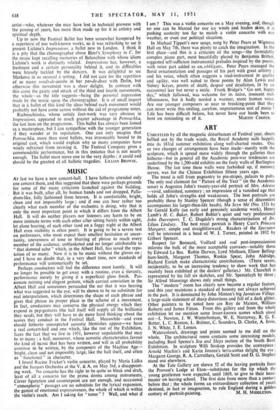ART
UNRUFFLED by all the magnetic disturbances of Festival year, sheets bellied out by the trade winds, the Royal Academy sails happily' into its 183rd summer exhibition along well-charted routes. One or two changes of arrangement have been made—mostly with the sculpture, which is spread more widely through the galleries than hitherto—but in general all the Academic post-war tendencies arc underlined by the 1,200-odd exhibits on the fusty walls of Burlington House. The last time these walls were furbished up, if memory serves, was for the Chinese Exhibition fifteen years ago.
The trend is still from pageantry to pin-stripes, palaces to pubs. The only real claimant for "Picture of the Year" (in the Academic sense) is Augustus John's twenty-year-old portrait of Mrs. Adeane —vivid, unfinished, summary ; an impression of a vanished age that holds all John's strengths and weaknesses. The best portraits are probably those by Stanley Spencer (though a sense of .discomfort accompanies his larger-than-life heads), Ma Seyn Me (No. 153) by Sir Gerald Kelly (an early and genuinely academic work), Henry Lamb's H. C. Baker, Robert Buhler's quiet and very professional John Davenport, T. C. Dugdale's strong characterisation of Dr. Lilian Lindsay. The best royal portrait is Henry Carr's Princess Margaret, simple and straightforward. Readers of the Spectator will be interested in a head of W. J. Turner, painted in 1932 by Gilbert Spencer.
Respect for Bonnard, Vuillard and real post-impressionism informs the bulk of the more acceptable canvases—notably those by Edward Le Bas. Robin Darwin, Lord Methuen, Elinor Belling- ham-Smith, Margaret Thomas, Ruskin Spear, John Aldridge, Richard Eurich make characteristic contributions. (There seems, incidentally, to be an increasing tendency to- show work that has recently been exhibited at the dealers' galleries.) Mr. Churchill is represented by his full six sketches, and Mr. Spencelayh by three ; Sir Alfred Munnings shows only small things.
The " modern " room has clearly now become a regular feature, and this year maintains a standard of honesty not always achieved in the past. It is dominated by John Minton's big Jamaican Village, a large-scale statement of sharp distortions and full of a dark glitter. Other painters to be noted here are Roy de Maistre, William Roberts and James Fitton. From this gallery and from the whole exhibition let me mention some lesser-known names which stood out—J. Newton, J. W. Winterbottam, W. E. Narraway, R. G. E. Butter, L. C. Renton, L. Bulmer, C. Saunders, D. Clarke, A. Irvin, J. N. White, J. E. Lomas. Watercolours, drawings and prints seemed to me dull on the whole. The architectural room contains some interesting models, including, Basil Spence's Sea and Ships section of the South Bank Exhibition. In sculpture Willi Soukop provides the centrepiece ; Arnold Machin's and Karin Jonzen's terra-cottas delight the eye: Margaret George, R. A. Carruthers, Gerald Scott and D. G. Stephen stand out elsewhere.
At the Tate Gallery are shown 52 of the leaving portraits from the Provost's Lodge at Eton—substitutes for the tip which the young gentlemen were expected, until 1869, to give to their head- master on leaving school. The first date from more than a century before that ; the whole forms an extraordinary collection of youth destined, in fact or imagination, to rule England during a golden


































 Previous page
Previous page